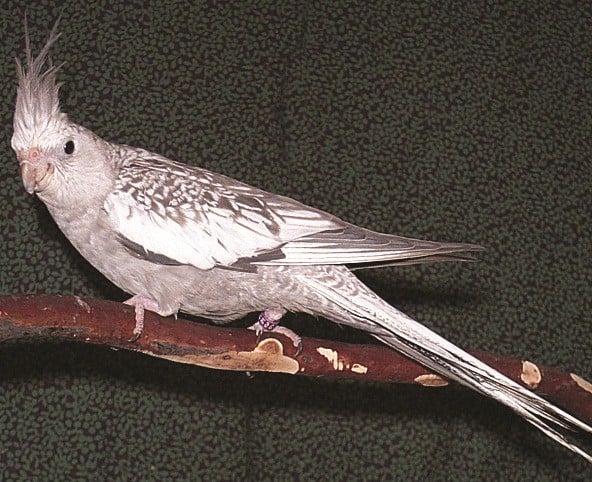
Species Profile Cockatiels
The cockatiel (Nymphicus hollandicus), is a member of the cockatoo family. They are prized as household pets and companion parrots throughout the world and are relatively easy to breed.
Small, long tailed and slender, these elegantly crested birds with small and narrow hook bills and foot structure make them agile climbers. Their wings are long and pointed. Many years of selective breeding has developed a range of colorful mutations.
Cockatiel Facts
- Tribe: Calopsittacini

- Species Name: Cockatiels
- Latin Name: Nymphicus hollandicus
- Country of Origin: Australia
- Availability in the Pet Market: Extremely popular, widely available, several generations of captive breeding
- Size: Reach 32 cm in length
- Weight: 80-110 gr
- Clutch Size: 4-7
- Number of Clutches: 2-3 per year
- Incubation of Eggs: 18-20 days
- Fledging Age (in the wild): 5 weeks (feathers fully grown)
- Average (healthy) Weaning Age: 9-12 weeks
- Reproductive Maturity: 1 1/2 yrs old
- Expected Life Span: 13-18 yrs in captivity
Cockatiel Behavior Rating – Scale of 1 to 10 (10 being the highest)
- Personality: (9-10) Sweet calm & gentle, fun & friendly, tremendous character.
- Sociability: (8-10) Gregarious by nature; they are exceptionally social if raised interactively. Many people should raise and train at once when young. Like any other parrots we must be careful of the one person bonding syndrome.
- Easily tamed and gentle: (9)
- Family companion bird: (9-10)
- Playfulness: (4) Enjoys swinging and chewing
- Biting behavior: (1-3) uncommon
- Physical contact & demonstration for affection: (7-8) Generally, female adore being stroked and caressed. Male enjoy to get handled but not caressed.
- Singing ability: (7-9) Males chatter & whistle melodies ; female mostly quiet
- Screaming strength: (2) Frequency: (7)
- Screaming pitch: (high pitch whistle)
Talking or mimicking ability: limited 0-3 female: 2-6 male boisterous & inquisitive nature - Quality of pronunciation: (7-8) Male: good, small clear voice
- Destructive behavior: (2) Due to its small size. Chewing activity: (8)
- What degree of independence can this species develop: (6) It is essential to encourage and develop this independence as early as possible.
- Eating flingers and messy droppings: (2 ) tidy & clean natured
- Tendency to engage in feather damaging behavior: (1) uncommon Caution: Do not expose to tobacco smoke
Cockatiel Sexual Dimorphism
The natural grey cockatiel: females have dull coloration of the crown, crest, cheek-patches and ear coverts. Tail feathers are irregularly barred and lightly marked with light yellow and dark grey. Sex can also be guessed by their behavior and facial coloration at 3-6 months. Whistling and singing accompanied by the bright facial coloration of adults is usually a sign for a male, but they will retain the barred tail until the first complete molt after which their tail will be dark grey. DNA sexing is advised to confirm sex.
Color Variations in Cockatiel
- Pearl (each feather retains gray color, with white interspersed)
- Albino (white feathers)
- Pied (Varying white patches cover the body)
- Lutino (body feathers white with yellow/white/orange face)

Cockatiel Housing Requirements
- How spacious should the day cage be: A bird cage should be spacious, secure and cleaned frequently. Ideally a minimum of 20” X 20” would allow them some movement, activity and prevent obesity.
- Keep bird cage in a safe location: Keep away from dangers such as direct sunlight, kitchen fumes, cold temperature and predators.
- Sleeping cage size requirements: 18” X 18” inches; it should to be at least 11/2 times the size of the bird with its wings fully expanded.
- Stimulate activity: Cage should have horizontal bars to encourage climbing, an open roof cage, play gym or flight is essential for exercise. Interior flight cages are easily constructed with small gage wire. Secure your home from any potential dangers before letting your bird fly around freely; always monitor its flight. (eg. Mirrors, open windows, fans)
- What perch sizes should be offered: Minimum 3 sizes or shapes & texture; Ideally 5/8” wooden perch, a manzanita perch type and a therapeutic perch.
- Additional in cage: Swings, toys, ladders and bells, twigs and safe destructible material, bath.
- Water Dispenser: Ideally, drinking water should be changed twice daily. Train to drink from a water bottle as well as water bowl because cockatiels love to perch and drop feces in bowls.

Cockatiel Dietary Requirements
Offer a balanced nutritional diet. 60% formulated /granulated pellets like Tropican. Plain seed mixes can lead to obesity as well as deficiencies in calcium and vitamins. Try to feed your bird formulated diets or at least provide nutritional seed such as Tropican Cockatiel food, 30% seed Tropimix mix, Tropimix egg granules, millet occasionally, 10% fruits, veggies, rice, pasta… healthy home cuisine.
Lighting Requirements for Cockatiels
8-12 hours of natural sunlight or full spectrum lighting. 12 hours of non-interrupted sleep, especially for females. Caution prone to night fright-thrashers; should have night lamp and remove excess toys at night.
Time Require to be Handled per Day
Ideally 1 hour per day of quality time, interactive activity, showering, training & flying. Caution: Avoid always having the bird on you! Let them develop independence.
Cost of a Cockatiel
$80-$300 Cdn depending on the color mutation and age.
How Susceptible is a Cockatiel to Disease
Hardy yet prone to obesity, egg retention, candida, some mutations are weaker, dependence syndrome similar to cockatoos (often recommended to have 2). Avoid drastic change of temperature and keep them away from danger as they are prone to explore.


